Flyfishing for Salmon
Introduction - Conservation - Tackle - Salmon Flies - Fishing Techniques - Casting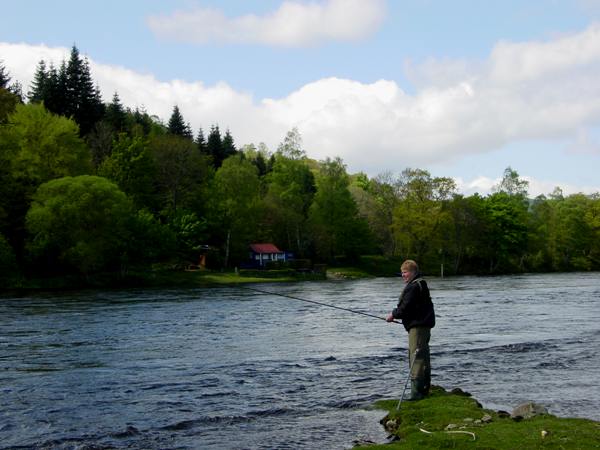
Compared with trout fishing, flyfishing for salmon is easy. Casting a salmon fly with a double-handed rod is, in our experience, much easier than casting a trout fly, and in most situations you don't even have to be particularly accurate or delicate in presenting the fly, because usually your fly hits the water well away from where the salmon is at the time. One other point is worth stressing right now: whereas there are times when and places where trout become very fussy feeders, and matching the hatch can be crucial, salmon are not trying to feed when they take a fly, and so the pattern is much less critical. That's not to say that any old fly will do, but rather that learning to choose and use the right fly is a much simpler business for salmon fishers.
So does that mean you are likely to catch lots of salmon? Sadly no, because salmon are so much scarcer than trout in most of the rivers you are likely to be able to fish.
If there were equal numbers of trout and fresh-run salmon in a river, we would be much more confident about being able to catch a salmon than a trout.
That doesn't mean that salmon fishing is lacking in challenge, but with a suitable tackle setup and by following a few simple guidelines about where and when you are most likely to find a salmon, you can very easily become a very good salmon flyfisher even in your first season. This section of our online flyfishing school will give you a great start towards achieving success and the satisfaction that comes with it.
Salmon conservation
We have said already that wild Atlantic Salmon are scarce almost everywhere nowadays. Their future is seriously threatened, and the only way we feel able to justify continuing to fish for them is to do so on rivers where the stocks are at least holding steady at a safe level (scientists refer to this as being above the 'conservation limit') and to return to the river quickly and with a minimum of handling all salmon that we catch.
If you visit a river where there is known to be a sustainable harvestable surplus, you may be allowed to take the occasional fish; however, knowing that cooked salmon do not spawn we choose to return all salmon that we catch - just because we know that some people will break the rules and take more fish than the rules allow.
Please see our guidelines on best practice catch and release and our online length-to-weight converter.
Flyfishing Tackle Guide for Salmon Fishers
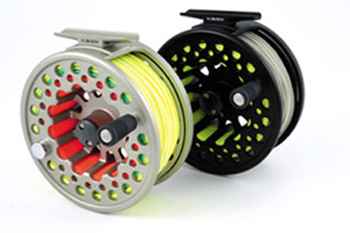
Just as with trout fishing you will find that the design of salmon rods, reels and lines is continually evolving, and there is no doubt that the new generations of carbon fibre rods are much better than their greenheart, cane and glass fibre predecessors. They are much lighter and easier to cast, and the fact that you can pack even really long salmon rods down into a size that can easily be stowed in a suitcase is a huge advantage if you decide to travel abroad to fish for salmon. In the advice presented here, (J-B) indicates a link to our Jargon-Buster page of plain English explanations of technical terms.
The fishing tackle needed for salmon fishing is expensive and so you need to think carefully about what you really need before rushing out in a fit of enthusiasm and being sold something completely inappropriate.
Rather than the size of the salmon you may catch, it is the size of the river where you will mostly fish that is the critical factor in determining the length and strength of the rod you will buy. For instance, if you usually fish on a smallish river you will find a 17 ft salmon rod a colossal disadvantage, and similarly if you fish on mighty rivers like the Tay in Scotland or the Varzuga in Russia you will be seriously 'under-gunned' if all you have is a 10 ft rod - even if it does have a so-called 'fighting butt' which enables you to cast it in double-handed style. Although it is not ideal we have caught (and successfully landed!) salmon on 9 feet (2.4m) long #6 and #7 weight trout rods when we were able to cover the water satisfactorily on smaller rivers, but given normal conditions on most salmon rivers a longer and more powerful rod is desireable since not only can you cast further but also such a rod will make light work of casting the heavy lines and weighted flies that most salmon fishing requires.
A good all-round solution would be a double-handed rod of around 13 to 14 feet (about 4m) in length. A good caster should easily be able to fish at a distance of 30 or even 40 yards (27 to 36m) with a rod of this length fitted with appropriate fly lines. It will certainly do for most eventualities.
Salmon fishing almost never takes place in ideal conditions (in the UK at least) because the best fishing is either in spring (much rarer these days as a result of the depletion of the spring runs of salmon) or in autumn and early winter when the vast majority of salmon are caught these days. The most common condition for salmon fishing is, therefore, high water rather than low water. In very low, clear water conditions you will fish with a floating line, a long leader and small flies, but no tackle setup can make extreme low water fishing for salmon better. In the more common situation of the water being high, the tackle you use and the way in which you fish can quite literally mean the difference between success and failure. In such conditions success will largely depend on getting your chosen fly down to the depth where the salmon are likely to see it, and this will almost certainly mean fishing a sinking line of one type or another, probably with a heavily weighted fly. Because of this it is most important when buying a salmon rod that it should have sufficient 'backbone' to cast a high density, ultra fast sunk line.
The Basic Essentials
If you are not sure where you wll end up fishing here is an ideal salmon outfit for getting started which will enable you to fish in most places and in most conditions:
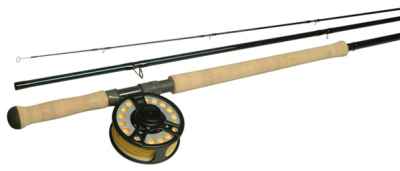
Double handed salmon rod between 13 - 15 feet (4 to 4.7m) long
Salmon reel - fitted with a floating line and with a spare spool fitted with a sunk line
A selection of flies ranging in size from small (size 12) to large (size 2) as well as a number of larger, heavy flies that will sink quickly.
A landing net - essential if you are going to be fishing off a bank
Nylon of various strengths to make up leaders - between 10 and 20lb (4.5 and 9kg) breaking strain. The general rule for a salmon leader is the smaller the fly the longer the leader should be and the lighter the tippet, especially if fishing in clear water. For casting heavy tube flies much shorter leaders - 3 feet (1 metre) maximum are required if massive tangles are to be avoided.
Multi-tip Salmon Fly Lines
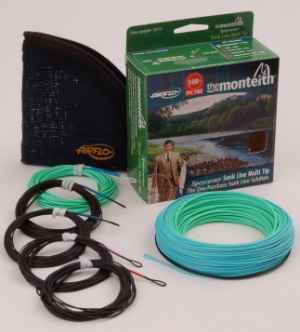
Salmon fly lines have undergone something of a revolution in recent times, and now in addition to the normal full floating lines for summer conditions and the fast sinking lines which are still the best option for very high water conditions, it is possible to buy so-called multi-tip lines. These lines are based on the shooting-head lines which have been popular in Scandinavia for some time. They consist of a relatively short head (in the region of 30 ft) followed by a long rear running line of approximately 90 ft.
The head of the line is fitted with a welded loop to which can be attached various tips of around 15ft in length depending on the conditions you are fishing in: floating, intermediate, fast sink and super fast sink. The loop to loop connections between the head of the fly line and the chosen tip have a considerable advantage over traditional lines because you only change the tip of the line and there is no need to wind in and either change reel or spool in order to fish in a different way.
Although it is possible to spey cast these multi-tip lines, many anglers, especially those who cannot spey cast well, find these shooting-head setups easier to cast and can achieve greater distances on large rivers.
Salmon Flies
We believe that choice of fly pattern is one of the least important considerations when salmon fishing. That's not to say that any old fly will do in any situation... far from it. The weight and size of a fly and the amount of dressing have a big influence on fishing results, but just don't be distracted by a vast array of colours: we are perfectly happy with just two patterns, but we have several sizes of each, some are heavily weighted while others rely only on the weight of the hook and the sinking characteristics of the fly line or leader to get them to the depth required.
Ensuring that your fly is likely to be seen by either running or resting salmon at various depths and in varying degrees of water clarity is crucially important, and the advice that follows is intended to optimise these aspects of fly performance.
Our favourite flies and how to use them
In our online guide to selecting salmon flies for various weather and water conditions on rivers, streams and estuary waters, you might have expected to see lots of different patterns. We could do that, but in our experience it really is quite unnecessary. What you do need is a small selection of flies in various sizes and weights that allow you to present a fly large enough to be seen by a salmon but not so big as to spook it. You also need to be able to present your fly at the right depth, and the design of the fly has a big influence of that.
How many flies do you really need?
We suggest that for virtually all salmon fishing you need only two fly patterns (and at a push you could probably get away with just one).
Ally's Shrimp
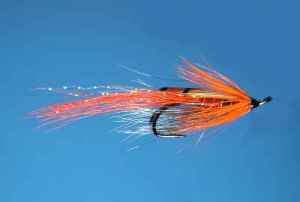
Devised by well-known salmon fisher Alistair Gowans, this simple orange fly is described as a 'shrimp' imitation; however, it's unlikely that accurately copying the shape of a real shrimp would make the fly any more effective. This fly, tied on double hooks in sizes 10, 8, 6 and 4 is our first choice when fishing on dull days or in water that is coloured rather than clear.
Ideal in high water or when rivers are in moderate flow, this fly is clearly visible when fished at more-or-less the same depth as the salmon. It does particularly well when fish are fresh in from the sea, but its effectiveness is reduced if the salmon have been a long time in the river and are taking only tentatively. The most likely reason for this is that the salmon may nip the long tail of the fly without engulfing the hook.
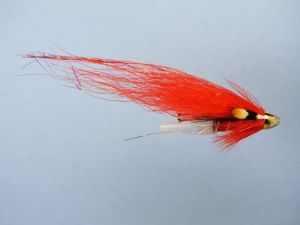
Ally's Shrimp can also be tied as a tube fly on either plastic, aluminium or brass tubes, and then we use double hooks in sizes 10 or 8 rather than trebles from which it is very difficult to release fish quickly.
Pictured on the left is another popular variant on the traditional Ally's Shrimp. This tube fly version is tied with a brass conehead, which ensures that it sinks very rapidly. Because this version is intended for fishing in fast water or in very deep parts of rivers, we recommend tube sizes of 1 to 3 inches (2.5 to 8cm) in length. The Jungle Cock feathers tied in as cheeks are an optional extra - they look very nice, but we are in no doubt whatsoever that their main attraction is to anglers rather than to salmon. Still, if you tie your own flies and like them to look good (to other anglers, that is) then including Jungle Cock cheeks is certainly a well-proven method of achieving this objective.
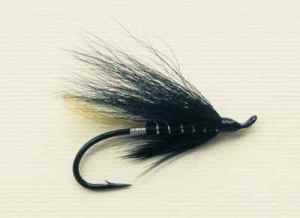
Stoat's Tail
For low-water conditions or when fishing in bright sunlight, we find this pattern ideal. For best results then dressing should be tied 'short' as shown here, with no material extending beyond the bend of the hook.
With Stoat's Tails tied on single hooks in sizes 12, 10, 8 and 6 you will be well equipped for low water salmon fishing.
Flyfishing Techniques and Tactics for Salmon
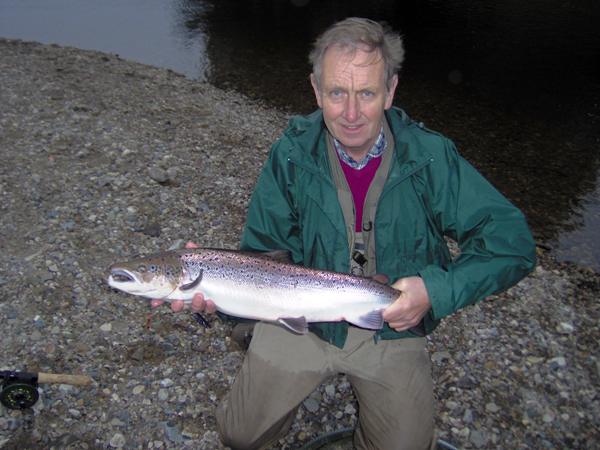
As with other kinds of fishing, success with salmon depends upon skill, knowledge and luck. Because the timing of the salmon runs varies from river to river, what is generally a productive period on one river may be a lean time on another. That said, you can book a fishing trip only to find the river a raging torrent or a pathetic trickle, so in that sense luck can play a big part; however, past performance of a river is a pretty good guide when choosing the dates for a visit.
Unfortunately, run times also vary from year to year. So, although timing your visit on past performance can increase your chances, even on the most prolific of salmon rivers there are no periods when success is guaranteed.
In recent years the larger rivers on the eastern side of the British Isles have tended to have the earliest runs of salmon, while the shorter and generally steeper rivers in the west generally provide their best salmon fishing later in the year. This was not necessarily so fifty years ago, when there were many more ‘springers’ on pretty well all major rivers other than those suffering from serious pollution. On most rivers entering the North Atlantic, the main salmon runs are now much later than they were even thirty years ago, and on some rivers the prospects of catching a salmon before July are now minimal. That said, stocks in a few places seem to be bucking that trend, with clear evidence of an increase in spring salmon and summer grilse.
The pattern of rainfall is a crucial factor, because unlike sea trout very few salmon leave the estuary and forge upstream until there is a strong flow of water in the river. Salmon fishing generally improves when we have a wet spring and summer, whereas catches are invariably depressed (as are salmon fishers too!) in drought years.
Runners and resters
Salmon travel up river in short bursts with periods of resting in between. While there is no evidence that running fish are less likely to take a fly than resting fish, what is quite clear is that the chances of a running fish seeing your fly are much reduced. You may get several chances to cast to a resting fish, but a runner can easily pass you between casts. Where the rules of the fishery require you to take a pace downstream between casts your prospect of catching any particular running fish are even further reduced; conversely, if the rules allow (or in some instances require) a pace upstream between casts there is an increased chance that any particular running fish will see your fly.
Most fish run well below the surface and often very close to the riverbed, and it helps if you can present your fly at or close to the depth the salmon are running. Sink-tip lines or full sinkers may therefore be necessary on all but the shallowest sections of river.
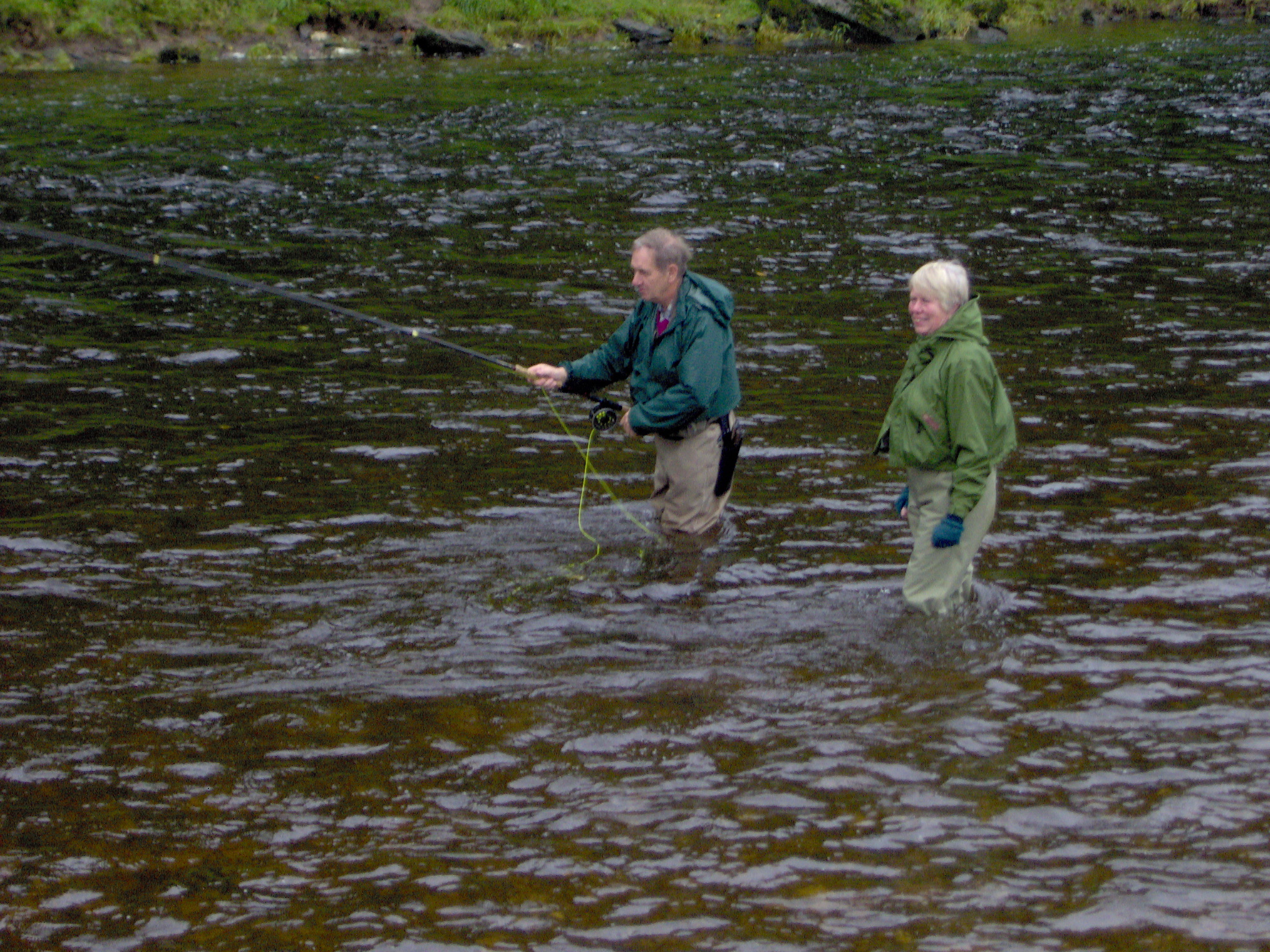
Except when the water is very cold, resting salmon will swim up to take a fly, and therefore it is often possible to catch resters using a floating line and a fly presented just beneath the surface (and occasionally even a floating fly - especially when boat fishing on a wind-swept lake). The key to success is getting your fly to swim over the lies taken up by resting fish. But how do you find these lies?
In low to moderate water, salmon run up the main channel, where there is a reasonably well defined current that they can sense: in near static water a fish has no way of telling which direction is upstream.
In high water there is a strong current almost everywhere, and in the the main channel the flow may be so strong that even a salmon would struggle to make progress. At such times you are more likely to encounter running fish in the slightly weaker currents either side of the main channel.
When the river is heavily in spate, salmon hug the banks, and the only side of the river worth fishing is then the one closest to the bank on which you are standing. Caste towards the far bank and allow your fly to sink as it swings across to the dangle beside your bank. Don't be in a hurry to lift off and recast; instead, retrieve a few yards of line slowly and be ready in case a salmon follows your fly and takes it. If you feel a take, do not strike or you will almost certainly pull the fly out of the salmon's mouth. Instead, release tension and let out a yard or two (one or two metres) of line so that your line is carried downstream by the current; now when you lift the rod the fly will be pulled in to the scissors of the jaw of the salmon. This is a very secure hook hold.
When a river is bank high or bursts its banks, salmon do not run; instead they hug the banks where the current is weakest and simply wait until the river level drops back. The fishing is often much better when a river is fining down and falling back than when it is rising and colouring up. (In this respect salmon fishing is very different from trout fishing, which is more often best just as a river begins rising and taking on a hint of colour.)
Finding the lies of resting salmon
There is no substitute for local knowledge. An experienced ghillie or guide can help ensure that your fly spends more time where salmon are known to rest. Some lies hold fish at all heights of water; others are productive only over a limited range of river flows. But for many of us part of the enjoyment of fishing is learning to read the river for ourselves, and so here are a few points that can help you find fish even if you have no local expert to guide you:
- Spring salmon running up river tend to rest in the depressions that occur upstream of or beside submerged boulders. Such areas of ‘broken ground’ are most productive when there is a strong flow. Look for the surface turbulence caused by water upwelling as it flows over a boulder, but be aware that the visible evidence is always some distance downstream of the actual obstruction.
- After struggling up a stretch of fast water, salmon often rest for a short while as soon as they enter the calmer water of a pool. There is usually a good ‘taking lie’ on a pool tail a few yards upstream of the point where the water begins breaking as it enters the rapids between pool.
- Grilse in particular seem to like the well-oxygenated water at the neck of a pool, and on summer evenings a fly drifted across the neck will often tempt a fish.
- Fast-flowing glides overhung by trees provide a shady respite for salmon working their way up river, and fish tend to rest there by day before continuing their upstream migration during the hours of darkness. Provided you move slowly, the turbulent nature of such streamy and perhaps weedy water can help you to get closer to the fish without being seen.
Shadows on the stream
On bright days the moving shadow that a floating line casts on the riverbed can startle fish. At such times it is advisable to use a longish leader - 12 to 18 ft (3.5 to 5.5 metres) may be necessary) to keep the fly well away from the very visible fly line and its shadow.
Salmon in stillwaters
Salmon can also be caught on the fly on lakes, loughs and lochs within river systems. Boatmen who know the salmon’s migratory routes through such large stillwaters are able to set you on a drift where catching a fish is more than just a chance in a million. If you can't get help from such an expert, you can nevertheless increase your chances considerably if you fish near the outflow from a lake early in the morning and move to a position near to an inflow as dusk descends.
Fly size and pattern selection
Most experienced salmon fishers use but a small selection of fly patterns, but they vary the size according to water height, temperature and clarity. When fishing deep down a larger fly usually works better than a small one, and in low light conditions or when visibility is limited by water turbidity a small fly is even more likely to go unnoticed. In contrast, on bright days too big a fly can certainly scare fish that might otherwise take a smaller fly. Here are some guidelines for selecting flies to suit various river conditions. Single hooks are assumed, and so if you use doubles or trebles they may need to be one or even two sizes smaller. We have chosen Ally’s Shrimp, which shows up well and is very successful in coloured water, and Stoat’s Tail - a dark pattern that seems to be particularly effective when fishing for shy salmon in clear water. You will need them in a range of hook sizes.
River Height |
Water clarity |
Fly pattern |
Fly Size |
High |
Coloured |
Ally’s Shrimp |
2-4 |
Low |
Coloured |
Ally’s Shrimp |
6-8 |
High |
Clear |
Stoat’s Tail |
8-10 |
Low |
Clear |
Stoat’s Tail |
10-12 |
The Value of Local Flies
There is a lot to be said for obtaining local expert advice before tying or buying flies to fish on a river that is new to you. If nothing else it can be a confidence booster to know that you are using patterns that have been successful in the past; and confidence nurtures concentration, which is another key ingredient of flyfishing success.
Moving the fly
It’s not just fly line density that sets the depth. The size and weight of the fly also affect the rate at which it sinks. A sparsely dressed fly of a given size and weight will sink faster than a heavily dressed one. Fine leaders cut through the water more quickly than thicker ones. And where you cast your fly also affects the rate of sinking.
If you cast across the river at right angles to the flow, the current will bring your fly more quickly towards your bank than if you cast at an oblique angle downstream. If you cast upstream and across the fly will initially sink with minimal drag before it begins swimming across the river. By varying these factors you can control of the depth, the speed at which your fly travels, and the angle of presentation across the nose of a salmon. Finding the right combination of depth, presentation angle and speed can be crucial to triggering a response from the salmon.
There is something else that you can control, too, and that is how your fly moves. Salmon that have seen lots of debris drifting by are not likely to grab at everything that passes their noses. Many salmon fishers say that giving the line a series of short pulls to make the fly behave like some kind of living creature increases their catch rate. There could well be something in this: the most successful salmon fishers are more than just good casters.
Advanced techniques and tactics
The basic fishing techniques and tactics covered here will get you started. Many other refinements have been devised to cope with particular challenging situations, and the fun of flyfishing is that no matter how good you become there are always unfishable places, uncatchable fish that with the right approach and casting skill could somehow be tackled. Learning from others is a great help, but in salmon fishing there is something else that can pay off too: if you are not catching fish and you know that there are salmon in the river, change something: try a small or larger fly; fish deeper (shallower is rarely any help in our experience); move the fly faster or more slowly; move so that you cast to potential lies in a way that your fly is likely to hold there just a little bit longer. In short: experiment, but always make a note of what you are changing, so that if it proves successful you can try it again when similar challenges present themselves.
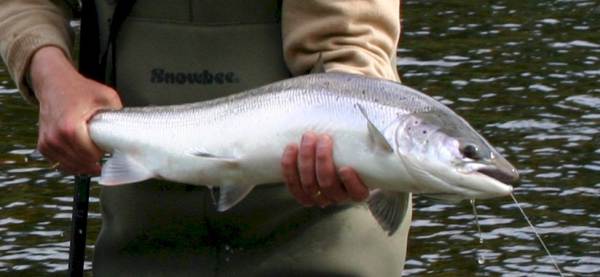
Hooking and landing salmon
What should you do when a salmon takes the fly? Should you strike or simply wait until either the force of the current on the line sets the hook or the salmon does so as it swims away from you? Experts don’t all agree on this, but most suggest that waiting is usually better than striking immediately and risking pulling the fly from the salmon’s mouth. So much depends upon how the salmon takes the fly.
A fish swimming behind a fly that has already swung round onto the ‘dangle’ is unlikely to be hooked securely unless given time to turn back towards its lie or to run on upstream, when the pressure of current on the line will pull the fly towards the most secure hooking area of all: the ‘scissors’ of the fish’s jaw. Takes on the dangle are particularly common in high-water conditions, when salmon tend to run up river close to the bank where the current is more manageable. So when fishing a river in spate, it usually pays to hold the rod tip high and let a taking fish tighten the line before you put any pressure on the rod.
In low-water conditions resting fish can be difficult to hook, and it is not unusual to have your fly taken and quickly rejected. If this happens repeatedly there are at least two responses worth trying. The first is to strike immediately - but of course you then run the risk of hooking the front of the salmon’s jaw, and that is not always a very secure hook hold. Another tactic is to switch to a smaller fly. Very often a salmon that would only play nervously with (or even be spooked by) a large fly will take a smaller offering with confidence, turning away with the fly so that it lodges into the scissors.
Salmon flies can be tied so that they are more effective in low water conditions when the fish take tentatively: the dressing is shortened so that no material extends beyond the point of the hook. You can think of this as tying a size 12 fly on a size 8 hook, for example. For these kinds of conditions we recommend sparse dressings rather than heavily dressed flies; in this way you can have the strength and holding capability of quite a large hook without the fly appearing so big that it spooks the salmon you are trying to catch.
The rod as a shock absorber
Even a small salmon can break a leader if there is nothing to absorb the shocks as it leaps and splashes on the surface. To ensure that the rod acts as an effective shock absorber, always keep the rod held high. Release line if the fish pulls hard, and reel in line when the resistance decreases. Once a salmon turns onto its side, keep its head up on the surface and you will be able to draw the fish towards your waiting net (or a waiting hand). If you intend keeping the salmon, kill it immediately using a priest; and if you intend releasing the fish it is even more important to do so without delay.
See also our Casting Instruction page...
Excited at the prospect of flyfishing? So are we, and we're pretty sure you would find the Winding River Mystery trilogy of action-packed thrillers gripping reading too. Dead Drift, Dead Cert, and Dead End are Pat O'Reilly's latest river-and-flyfishing based novels, and now they are available in ebook format. Full details on our website here...
Buy each book for just £4.96 on Amazon...
Please Help Us: If you have found this information interesting and useful, please consider helping to keep First Nature online by making a small donation towards the web hosting and internet costs.
Any donations over and above the essential running costs will help support the conservation work of Plantlife, the Rivers Trust and charitable botanic gardens - as do author royalties and publisher proceeds from books by Pat and Sue.
